Case Analysis: Dr. Surajmani Stella Kujur v. Durga Charan Hansdah (2001) | Marriage under Hindu Law
The case of Surajmani Stella Kujur v. Durga Charan Hansdah (2001) examines the issue of bigamy and its associated legal repercussions.

This case holds significance in examining the interaction between tribal customs and statutory law, particularly concerning the application of Section 494 of the Indian Penal Code (IPC) on bigamy and the Hindu Marriage Act, 1955.
Case Title: Dr. Surajmani Stella Kujur v. Durga Charan Hansdah & Anr
Court: Supreme Court of India
Citation: Special Leave Petition (Crl.) 2436 of 2000
Judges: Justice K.T.Thomas & Justice R.P.Sethi
Date of Judgment: February 14th, 2001
Facts
- The Appellant, Dr. Surajmani Stella Kujur, belonged to the Oraon tribal community and the Respondent, Durga Charan Hansdah, belonged to the Santhal tribal community. Both of them were governed by clause (25) of Article 366 of the Constitution of India.
- The appellant and the respondent although belonging to the tribal community were married as per the Hindu rites and customs. Both the parties also professed Hinduism.
- The respondent had subsequently married another woman during the subsistence of the first marriage with the appellant, hence, committing the offence of Bigamy.
- The appellant filed a suit with the Court of Chief Metropolitan Magistrate, New Delhi, claiming that she and the respondent were married in Delhi by “Hindu rites and customs". The appellant requested maintenance, succession, and other benefits since she was the respondent's lawfully wedded wife, and she argued that Section 494 of the Indian Penal Code, 1860 applies to her which infringes her basic rights.
- The parties were allegedly governed by a Santhal custom being practised for a long period among their community as per which the commission of the second marriage by one party during the continuance of the first marriage is considered valid.
- The appellant, however, refuted this claim and said that a custom with legal standing forbids the solemnization of second marriages and outlines the consequences that follow.
- The Trial court dismissed the complaint and an appeal was made.
Issues
- Who is a ‘Hindu’ for applicability of the Hindu Marriage Act, 1955?
- Whether the tribal custom pleaded by the appellant has the force of law?
- Whether the alleged Santhal custom validate and encourage Bigamy?
Laws Applied
- The Constitution of India, 1950
- Hindu Marriage Act, 1955
- Indian Penal Code, 1860
Arguments before Court
The appellant contended that her husband's second marriage, which she viewed as a violation of her fundamental rights through the practice of bigamy, was justified as a custom among tribal people. She asserted that her husband should be punished under Section 494 of the Indian Penal Code for engaging in bigamy.
On the other hand, the respondent argued that the second marriage was legitimate as it aligned with the long-standing custom of the Santhal tribal community, which permits such unions. The respondent further argued that the appellant had no grounds to defend her rights, as she had participated in the marriage following their customs. The appellant maintained that the Santhal tribe's custom promotes the practice of bigamy.
Judgment
The Trial Court, however, rejected the complaint, ruling that citing the Book alone is insufficient in the absence of pleadings and supporting documentation since there was neither mention nor proof of a custom that prohibited second marriages. The High Court maintained the dismissal, stating that tribal customs would take precedence and that bigamy could not be proven in the absence of a notification under Section 2(2) of the Hindu Marriage Act, 1955.
The Supreme Court dismissed the appeal, emphasizing two main points:
- Custom and Offence: The court held that customs cannot create an offence. Offences must be defined by statutory law in force at the time of the act. Customary practices may influence civil rights but cannot establish criminal liability. This can be used to support a case since, according to Article 20 of the Constitution, no one can be found guilty of a crime they did not commit at the time of the offence.
- An act must be illegal at the moment it is committed for Section 494 to apply and penalize it. To establish the nullity of a second marriage, the petitioner must provide evidence of a custom that renders the marriage invalid or unenforceable. According to Section 494 IPC, which requires the prosecution to establish the existence of every element constituting a common and defined offence, the second marriage is null and void, making it inapplicable.
The court reiterated that for a custom to have legal standing, it must be ancient, certain, and reasonable. The burden of proving such a custom lies on the party asserting it.
The burden lies with the party relying on a customary practice to establish its validity through unambiguous evidence.
Section 3(a) of the Hindu Marriage Act defines "custom and usage" as follows:
"Custom and usage denotes practices and rules that have been consistently and uniformly adhered to for an extended duration, thereby attaining legal recognition among Hindus within a specific geographical area, tribe, community, group, or familial context."
As long as the rule is clear, not irrational, and consistent with public policy; moreover, if the rule alone applies to a family, it has not been discontinued by the family”.
Thus, for a custom to be legal and binding, it must be of immemorial origin and must be recognized by the court as reasonable.
However, in this case, both the appellant and the plaintiff failed to address the alleged custom mandating monogamy, resulting in the invalidity of the second marriage, making it unenforceable and lacking legal authority. The appellant did not present solid proof to demonstrate that the tradition of monogamy in their community was legally binding.
Applicability of Hindu Marriage Act: According to Section 2(2) of the Hindu Marriage Act, the Act does not apply to scheduled tribes unless notified by the Central Government. Since no such notification had been issued for the tribes in question, the Hindu Marriage Act did not apply to them. The court clarified that individuals belonging to scheduled tribes are not considered Hindus under the Act unless notified otherwise by the government. Even if such a notification were issued, the Act would still apply to scheduled tribes and scheduled castes under a specific subsection of the Act.
The court determined that the Hindu Marriage Act did not apply to the parties involved, despite their affiliation with Hinduism. The appellant acknowledged that the petitioners were tribal members who professed Hinduism, but their marriage fell outside the scope of the Hindu Marriage Act, 1955, due to Section 2(2) of the Act. Therefore, their marriage was governed solely by Santhal customs and practices.
As a result of the inapplicability of the Hindu Marriage Act and the absence of evidence regarding a tribal custom against bigamy, the court concluded that no offence under Section 494 of the Indian Penal Code could be established.
The Trial Magistrate and the High Court rightly dismissed the respondent's case, stating that without pleadings, evidence, and proof of the alleged custom rendering the second marriage void, no offence under Section 494 of the Indian Penal Code could be established against the respondent. Consequently, the appeal was dismissed, and no grounds for prosecution for bigamy were established against the respondent.
Conclusion
This case illustrates how Indian tribal customs and statutes interact and the difficulties that arise when personal laws and customs clash with criminal laws. It also highlights the importance of presenting substantial evidence when relying on customary laws to prove criminal responsibility and how important it is to present clear and sufficient evidence when asserting customs in court. It also clarifies the restrictions on applying personal laws to tribal practices and the legal definition of "Hindus" under the Hindu Marriage Act.
Click Here to Read the Official Judgment

